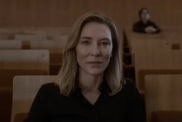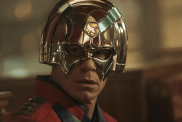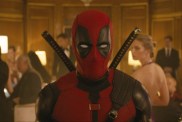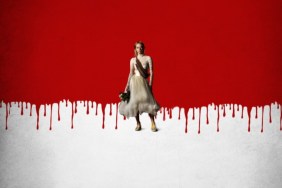So far, 2009 has seen the emergence of many promising new additions to the world of science fiction and fantasy, whether it’s Neill Blomkamp (District 9) or Duncan Jones (Moon) or Sophie Barthes (Cold Souls)–all of whom we’ve interviewed–and certainly, Shane Acker’s name will probably be added to that list once people see his animated feature film debut 9.
Based on his earlier Oscar-nominated short of the same name, the feature version follows the journey of an animated cloth doll known only as “9” (voiced by Elijah World) as he journeys through a post-apocalyptic world where humans are gone, replaced by fantastic mechanical creatures assembled from everyday found objects like scissors and such. As he makes his way through this world, 9 meets others like himself–numbered “1” through “8”–as they try to solve the mysteries behind the world while fighting off attacks from these unstoppable beasts.
Though proof of Acker’s talents are clearly evident from the imaginative creatures and inventive visuals used in creating their environment, Acker also had the benefits of two visionary filmmakers overseeing and helping him out when needed with Tim Burton and Timur Bekmambetov (Night Watch, Wanted) acting as two of the film’s producers.
At Comic-Con in San Diego this past July, ComingSoon.net had a chance to sit down with Acker and Bekmambetov to talk about how this innovative film came together.
ComingSoon.net: I know this movie started with the short which you finished maybe five years ago? So who found it and decided to stretch it out into a feature? Was that your doing, Timur?
Timur Bekmambetov: No, Jim Lemley.
Shane Acker: Yeah, Jim Lemley, he’s an independent producer. I guess he worked with Icon Pictures and Mel Gibson for quite a while and I took a meeting with him and he saw the short and just fell in love with it, so we started a conversation. “Where did this world come from? Who are these characters?” and we started talking about the backstory to the short, and he said, “Why, I think you might have a movie here.” That’s when we started writing a treatment, and while I was working on the treatment, he sent the short onto Mike Simpson, who is Tim Burton’s agent and Mike Simpson was like, “Wow, this is really incredible. Let’s get this in front of Tim and see his response.” So Tim really fell in love with the short, liked it and we ended up doing a telephone pitch to Tim and I remember at the end of the call, Tim’s like “I love this world, I want to be a part of it in anyway that I can help, just sign me up.”
CS: So when did you come in, Timur?
Bekmambetov: I’m a partner with Jim Lemley, we’re partners. I was at the Berlin Film Festival with “Night Watch” or something and I received a DVD with the short. I remember I put it in the player and it was like you see the world through the door, but it’s just a little bit open and you want to open it to see more.
Acker: We were trying to figure out how to make it. We knew that we wanted to make it for a smaller budget than a lot of the animated films because we wanted to really protect it and shape it and take some chances, take some risks. Explore some territory that a lot of animated films don’t, so we partnered with Timur to try to figure out how we’re going to do this. How are we going to make this film? Timur is renowned for making amazing films for very modest budgets, so he was really involved with that process of trying to figure out how to do it.
CS: Besides doing the CG for your movies, was this the first time you were involved with a full animated movie?
Bekmambetov: Yeah.
CS: Did you always have an idea of the backstory or how you might want to expand the short if given a chance?
Acker: No, I had the idea for the backstory and how the world came to be and these creature and characters in broad strokes, because I come from a design background and I know that in order to design the world, you kind of have to understand the history of the world and bring that to the present day, to the time in which the world is taking place. I had a lot of those ideas although they weren’t really refined or collected in such a way. And I think that’s what attracted people to the short or what they saw in the short, a potential to be something longer form is that it feels, as Timur said, like just a slice of time of some larger narrative. So when I presented those ideas to Jim, then we just started working on them and refining them and trying to wrangle them down into a feature length project.
Bekmambetov: Even in the movie, you still feel that the door is not all the way open. You want to see more and know more about the story, and I think that’s the next movie.

CS: What was it that initially appealed to you? Was it the character or the environment?
Bekmambetov: It’s the first time it’s not dancing animals, it’s the first time when it’s animation when it’s a real world. It’s a fantasy world, but it’s not a cute world.
CS: Before you started working on the script for the feature, did you already have some of the other characters and creatures developed in your mind?
Acker: Yeah, it’s loosely in the short because you see on the back of the creature’s back when he is killed all those other dolls, but I didn’t really have a sense of who those characters were. After working on the short for like four and a half years, I was ready to move onto something else. I was like, “Oh, man, am I going to spend another three or four years working on this?” But once I started thinking about who these other six or seven characters are, it really became exciting again to figure out what their idiosyncrasies, what their characters are, what their strengths are. What we really sought out to do was that each character has their own strength and weaknesses, their own distinctive personalities and traits. We begin to learn that it’s together as a group that they compose the individual, so by themselves, they can’t really overcome or solve the problem so 9 comes along and realizes that in order to collect them all is how they’ll be the strongest and that ties into the core idea about the creator giving different parts of himself to make them, so they are different facets of him in some way.
CS: What did you want to bring to the project as one of the producers on this?
Bekmambetov: Just to help Shane to make it. Just to help him, because we are directors also, so we understand how bad to be and how to pressure.
Acker: Yeah, it was really unique to have two mentors like that and two filmmakers and what was great was that I was down in the trenches putting it together and when you’re down at that level, it’s hard to see the big picture and we’d present it to Tim and Timur, and they had that critical distance and could talk about the larger issues, the more global notes and direction of the piece, which was great. It was great to get that stuff and help you as a director step back and look at it and see what they’re talking about and go back in and try to refine it, tighten it up.
CS: As a creative person yourself, is it hard to offer input on someone else’s movie without steering it more towards your vision of how it should be?
Bekmambetov: That was the whole reason to be involved, because part of his vision is exactly how I see it so that’s why it was easy.
CS: How did the voice casting come together? Was Elijah the first person involved in terms of providing the voice of 9? It seems like a very eclectic voice cast.
Acker: It is a very eclectic cast. I was trying to think back to who was the first person… it was either Christopher Plummer or Elijah was the first one to come, maybe it was Elijah. When we were thinking about the actors, this film, unlike other animated films, it’s very naturalistic, it’s very realistic, it’s almost live action in some sense, so we wanted the actors to speak in their own voice, not to push it, not to be too cartoony or too broad like other animated films. We were really trying to find those actors that we thought had the traits and the personalities of the characters in the film. Elijah really embodies 9 in such a way as well as Christopher Plummer and Martin Landau, and we asked them to speak in their own voice, but help us also find the characters naturally. I think it makes the characters very believable and I think after a while, you stop thinking of these things as these stitch-punk creatures and really start seeing the humans inside them.
CS: Did you record all the voices first? What was the process in terms of voicework vs. doing the animation in this case?
Acker: Usually, you do the voicework first and then the animation, except that it was a really accelerated project so we tried to do that as much as possible but sometimes you end up changing the story or you’re trying to refine a scene, you’ll end up scratching the voice out there and having to get it to the animators to start to shape it and when you get a chance to get the actors in, you’ll record them and the animators will then refine based on the performance that they give. But sometimes, you’ve just gotta get started, gotta get going.

CS: I really loved the look of the film and if I didn’t know better, I would think it was done stop-motion because of all the textures and everything that looks so real. So what size team did you have working on this with you because I can’t imagine you having a thousand people like Pixar has there.
Acker: It was just me pretty much… (laughs) You know, you start small and then you swell, and we must have had two hundred some people at one point working on the project. When all the departments are firing… you kind of pass the assets down the chain then each department takes it, so by the time one shot is done, you might have had 20 to 30 people all touching that shot at some point. When you’re height of production, it’s a well-oiled machine, like a factory cranking out the footage. It was a huge team and a really dedicated group of artists, some really talented guys. I think they were really excited by this project because it allowed them to flex artistic muscles that they weren’t allowed to on other projects. Other projects, they tend to be tame or comedic and we really wanted something robust and cinematic and powerful, visual, and we were able to take risks and go places that other films aren’t. I think that really inspired people and they really brought a lot to the table.
CS: Did you do a lot of the storyboarding or basic animation to start with, even just stick figures, to get things going and lay things out?
Acker: I didn’t do everything myself. I did design the characters but I also worked with an amazing production designer, Robert St. Pierre. We really are making a world and we got nothing for free. We had to build everything from the pebble to the destroyed cathedral and that’s just a tremendous amount of work to make a world, so there’s no way that I could do it by myself, so I had to depend on really talented leads that could organize the teams to create the world and the characters. But I was actively involved in storyboarding and we would storyboard everything first to rough it in and shape the story and figure out the direction and the shots that are going in. Then you’d go onto layout where you really start to explore the cinematography, almost like pre-vis, and refine that before you commit to animation, because once you start animating, things get really expensive and you don’t want to start changing your mind after you’re animated.
CS: As far as the textures and fabrics used to create the characters, did you design any of your own software to create any of it, because it seems there’s a lot of things I’ve never seen before.
Acker: No, we used Maya as the basic tool for production. I think the great thing now is that a lot of these things have been solved, like cloth and fur and hair and water, so now it’s about “here are all the paints. What are you going to make out of that?” Which is really great, because then you can concentrate on the story and the creation of things and not be so bogged down with all the technical aspects of it. In any production, there are particulars for that one piece, so you’ll work the tools and reshape them to work for your film. For us, the big challenge was the amount of detail, destruction, rubble, all the stuff in the world, so they really did make their own suite of tools to deal with that.
Bekmambetov: And they were very smart, because they had limitations because of the budget, and when you have limitations, you have unique solutions and it doesn’t look like any other movie because they didn’t get a chance to render everything and they had two layers, there’s a lot of matte painting in the movie, and the matte painting gives the look of the classical paintings and it looks richer.
Acker: Yeah, it looks romantic like a Turner painting.
Bekmambetov: It’s like an art. And the second thing that happened is because they didn’t render the backgrounds–it’s matte paintings–you have a very unique 3D effect because the foreground is 3D and background is 2D, you feel like it’s a 3D effect. You don’t need the glasses. You feel like it’s a 3D world.
CS: Was there ever any talk of doing the movie in 3D? Obviously as you were making this, “Coraline” was being made and there was a lot of that stuff happening that would have made it possible.
Acker: Only towards the very end, unfortunately, but my approach as a filmmaker is that I want to explore space and I want to create depth, so I think Timur is picking up on the fact that we moved the camera and the way we set up the shots, we really tried to push the dimensions. It’s technically not 3D but I think it has that quality, and I think it would make an amazing 3D film.
Bekmambetov: And you need a very specific reason to make it a 3D film because just to make it 3D because you have a projector for 3D is not really a good creative choice, it’s just a technical one.

CS: I have to agree. While I’m hesitant to make comparisons to the movies from Pixar Studios, that’s really the watermark these days, and I thought this was as good as some of the movies they’ve made in terms of the visuals and character development, especially considering how much little it cost to make.
Acker: Wow.
Bekmambetov: No, no, it’s good. Disney and Pixar, they’re monsters, but we’re independent. This movie is the Resistance.
CS: You’ve done a lot of CG in your films, Timur. When you looked at the results of their animation did you wish you could use some of these guys on your projects?
Bekmambetov: I guess. I don’t know. I learned a lot. It was for me a very interesting process, because I learned a lot of interesting things.
Acker: Yeah, Timur is really excited and was like, “We need to make more animated films.” I think he would be an amazing animation director and that it would come very naturally.
CS: Absolutely. It would definitely be interesting to see him using his storytelling methods but using more animation.
Bekmambetov: There will be more blood and R-rated animation.
CS: I hope I’ll have a chance to talk to Tim Burton sometime about this, because he’s been such a big purveyor of stop-motion, even though he has used a lot of CG on his movies, so I’m curious to hear his take on this.
Bekmambetov: What I like in his world is that it’s very grounded. He’s created contrast between romantic stories and romantic characters and they’re very grounded. Heightened reality but a grounded world.
CS: Now that you’ve finished the movie, do you have any idea what you might do next? Are you going to try and develop something else or continue to work with Tim or Timur to do something else?
Acker: Yeah, we’re actually trying to seek projects and talking about the sequel to “9,” we’ve been talking about that.
CS: Would that be called “10” or “9 1⁄2”?
Acker: (laughs) I don’t know. It’s been a big year of 9 movies, it’s kind of crazy. There’s “District 9.”
CS: You should try to meet Neill if you get a chance. Besides having movies with “9” in the title, you two have a lot of common. He also started by doing a short on his own, very low budget and he has Peter Jackson as his producer/mentor. I suggested to Focus and Sony they should have the two of you meet and do something.
Acker: That would be fun. I’d love to meet him. I’m actively looking at other projects and I’m developing a feature based on this comic book series. Nothing has really been announced right now but I’ve actually been looking for other projects.
CS: But you’ll stay in animation?
Acker: Animation is my true love and I think we’re just opening the door for the possibility of what animated films can be. We’re on the cusp of it so I’m really excited to explore the medium, but also looking at live action projects, too, things with a pushed reality, fantasy element and world-making, because that’s really of interest to me. But again, how do you make a completely unrealistic fantasy world but grounded so that it feels very real and tactile and the characters and emotions feel real. That’s something I’m really interested in continuing to explore.
CS: Timur, I happened to talk to Mark Millar yesterday and he said that you would start shooting “Wanted 2” in 8 weeks. That can’t be true, can it?
Bekmambetov: He is very provocative. We will start pre-production in 8 weeks, not production.
CS: You’ve been attached to a lot of other movies, so have you been working to develop some of them?
Bekmambetov: Yes, yeah, we’ve been developing “Moby Dick,” for example, which is my true love. We’re making it all about Moby Dick as Frankenstein, it’s a supernatural creature. The concept is that if you have a supernatural creature than you need whalers with supernatural abilities.

CS: So this is more of a fantasy version of “Moby Dick” rather than another adaptation of the book.
Bekmambetov: Yes.
CS: Are you developing them all to direct yourself or maybe to work with other directors?
Bekmambetov: No, I like to communicate, that’s my nature, I like to be a part of the team.
Acker: Yeah, Timur was active in recutting the film and editing “9” which was a great experience for me. I learned a lot just being in the room.
CS: Was the movie a lot longer at one point?
Acker: No, we always sort of balanced around the same.
Bekmambetov: There was no money to make it longer. (chuckles)
Acker: Yeah, but it was really about trying to refine the characters and strengthen the characters, and I learned a lot from Timur how you can change the perception of a character through cutting and editing. It was really incredible to work with him on that.
9 opens on Wednesday, September 9. To watch trailers, TV spots, featurettes and clips, as well as view photos, click here.









